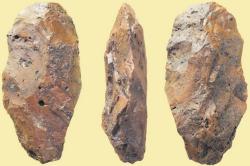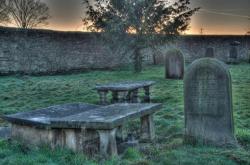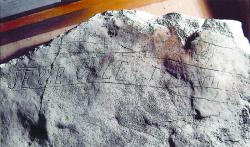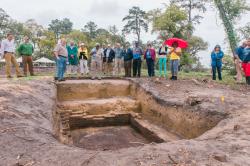INSTITUT SUPERIEUR D'ANTHROPOLOGIE
INSTITUTE OF ANTHROPOLOGY
ONLINE COURSES / COURS A DISTANCE
FALL TERM : OCTOBER 2015
REGISTER NOW
UAE –  Al Dhaid - Stone axes, scrapers and awls thought to date back hundreds of thousands of years have been unearthed at a newly discovered archaeological site in Al Dhaid. A team of archaeologists from the Department of Antiquities and Tubingen University in Germany found a large quantity of stone tools at the site in the central region of Sharjah. Dr Sabah Jassim, head of the local archaeological team, said the items are being analysed to determine their exact age. “We have sent several items, including axes and scrapers, to Germany for further analysis, said Dr Jassim. “The discovery of these tools will add valuable information to our records about the Stone Age in the emirate, and the early history of human groups and their predecessors in this region.” Awls were used to puncture the leather of animal hides, while scrapers were used to clean the leather by scraping away the meat and fur. Several excavations have been carried out in Sharjah at Al Dhaid, Al Madam and Al Faya in recent years. Objects unearthed in these locations were similar to those found at the new site. Last year the DoA discovered anvils, hammers, pottery and the remains of smelting and copper workshops. Human skeletons were found in a mass grave containing pottery, glazed jars, weapons and burial gifts, as well as a rare collection of glass bottles.
Al Dhaid - Stone axes, scrapers and awls thought to date back hundreds of thousands of years have been unearthed at a newly discovered archaeological site in Al Dhaid. A team of archaeologists from the Department of Antiquities and Tubingen University in Germany found a large quantity of stone tools at the site in the central region of Sharjah. Dr Sabah Jassim, head of the local archaeological team, said the items are being analysed to determine their exact age. “We have sent several items, including axes and scrapers, to Germany for further analysis, said Dr Jassim. “The discovery of these tools will add valuable information to our records about the Stone Age in the emirate, and the early history of human groups and their predecessors in this region.” Awls were used to puncture the leather of animal hides, while scrapers were used to clean the leather by scraping away the meat and fur. Several excavations have been carried out in Sharjah at Al Dhaid, Al Madam and Al Faya in recent years. Objects unearthed in these locations were similar to those found at the new site. Last year the DoA discovered anvils, hammers, pottery and the remains of smelting and copper workshops. Human skeletons were found in a mass grave containing pottery, glazed jars, weapons and burial gifts, as well as a rare collection of glass bottles.
http://www.thenational.ae/uae/heritage/another-ancient-sharjah-site-found-by-archaeologists
EGYPTE –  El-Kab - Dr. Mamdouh El Damaty, Minister of Antiquities, announced the discovery of lower part of a royal statue showing the name of King “Sahure”, second King of the 5th Dynasty in the Old Kingdom. The statue bloc was unearthed during the excavations of the Belgian mission at El-Kab (15km north of Edfu) in Aswan governorate. The mission is directed by Dr. Dirk Huyge (Royal Museums of Art and History, Brussels). Dr. Mahmoud Afifi, head of the Egyptian Antiquities department, said “The discovered limestone statue base measures 21.7cm height and it is probably a part of a 70cm statue.” The minister emphasised the importance of the discovery as there are only 2 statues of King "Sahure" one of them on display at the Metropolitan Museum in USA and the other one at the Egyptian museum in Tahrir.
El-Kab - Dr. Mamdouh El Damaty, Minister of Antiquities, announced the discovery of lower part of a royal statue showing the name of King “Sahure”, second King of the 5th Dynasty in the Old Kingdom. The statue bloc was unearthed during the excavations of the Belgian mission at El-Kab (15km north of Edfu) in Aswan governorate. The mission is directed by Dr. Dirk Huyge (Royal Museums of Art and History, Brussels). Dr. Mahmoud Afifi, head of the Egyptian Antiquities department, said “The discovered limestone statue base measures 21.7cm height and it is probably a part of a 70cm statue.” The minister emphasised the importance of the discovery as there are only 2 statues of King "Sahure" one of them on display at the Metropolitan Museum in USA and the other one at the Egyptian museum in Tahrir.
http://luxortimesmagazine.blogspot.nl/2015/04/rare-old-kingdom-statue-was-discovered.html
ALGERIE –  Oussalit - Une pétition qui a regroupé plus de 1000 signatures montre clairement l’exploitation de carrières d’agrégats, au lieu dit Oussalit (la Vallée des rois) à Aïn Fakroun, situé à 25 km du chef-lieu de wilaya d’Oum El-Bouaghi. La documentation collectée par le mouvement associatif montre la mise en péril de découvertes d’une très grande importance : un double pressoir (d’olives) en pierre de plus de 4 mètres de longueur et 3 mètres de largeur, en plus de 280 tombes (sous forme de dolmens) sur plus de 100 hectares. Les initiateurs du mouvement associatif, qui étaient les premiers à donner l’alerte pour la protection et la réalisation d’un périmètre de protection, parlent de plus de 14 exploitations d’agrégats, et signalent que depuis 2009 rien n’a été fait. Pour eux, les carrières, les différentes machines et dynamites grignotent sur le terrain du lieu archéologique. Concernant la datation de la découverte, elle peut remonter à l’époque atérienne (6000 ans), selon Hocine Taoutaou, chercheur au Cnrpah.
Oussalit - Une pétition qui a regroupé plus de 1000 signatures montre clairement l’exploitation de carrières d’agrégats, au lieu dit Oussalit (la Vallée des rois) à Aïn Fakroun, situé à 25 km du chef-lieu de wilaya d’Oum El-Bouaghi. La documentation collectée par le mouvement associatif montre la mise en péril de découvertes d’une très grande importance : un double pressoir (d’olives) en pierre de plus de 4 mètres de longueur et 3 mètres de largeur, en plus de 280 tombes (sous forme de dolmens) sur plus de 100 hectares. Les initiateurs du mouvement associatif, qui étaient les premiers à donner l’alerte pour la protection et la réalisation d’un périmètre de protection, parlent de plus de 14 exploitations d’agrégats, et signalent que depuis 2009 rien n’a été fait. Pour eux, les carrières, les différentes machines et dynamites grignotent sur le terrain du lieu archéologique. Concernant la datation de la découverte, elle peut remonter à l’époque atérienne (6000 ans), selon Hocine Taoutaou, chercheur au Cnrpah.
http://www.liberte-algerie.com/culture/dimportantes-decouvertes-dans-la-vallee-des-rois-224690
ROYAUME UNI –  Ribchester - Roman remains near Preston are to be excavated once more for further understanding about their role in the Roman Empire. Ribchester is nestled in the Lancashire countryside in what was a key route between Manchester and Hadrian’s Wall. The University of Central Lancashire is leading a project with Historic England and Ribchester Museum to focus on excavating the monument, churchyard and existing historic houses. These are areas considered “at risk” by Historic England. Dr Duncan Sayer, senior archaeology lecturer at UCLan, said: “Ribchester is a relatively unexplored area of historical interest and we want to make people aware of its significance. It’s a very exciting project for our students to get involved in and they will not only be looking for Roman relics but also for evidence of the early medieval settlers who followed the Romans so it’s an important dating exercise. Students from UCLan are to work in two trenches 20 metres by 15 metres in diameter and will dig to collect artefacts, such as pottery and ancient coins, and log data about the site. The dig could last for up to three years depending on what is discovered.
Ribchester - Roman remains near Preston are to be excavated once more for further understanding about their role in the Roman Empire. Ribchester is nestled in the Lancashire countryside in what was a key route between Manchester and Hadrian’s Wall. The University of Central Lancashire is leading a project with Historic England and Ribchester Museum to focus on excavating the monument, churchyard and existing historic houses. These are areas considered “at risk” by Historic England. Dr Duncan Sayer, senior archaeology lecturer at UCLan, said: “Ribchester is a relatively unexplored area of historical interest and we want to make people aware of its significance. It’s a very exciting project for our students to get involved in and they will not only be looking for Roman relics but also for evidence of the early medieval settlers who followed the Romans so it’s an important dating exercise. Students from UCLan are to work in two trenches 20 metres by 15 metres in diameter and will dig to collect artefacts, such as pottery and ancient coins, and log data about the site. The dig could last for up to three years depending on what is discovered.
http://www.blogpreston.co.uk/2015/04/ribchester-roman-remains-to-be-excavated-in-major-new-dig/
ROYAUME UNI –  Moncreiffe Hill - Work is under way on Moncreiffe Hill, following last year’s joint excavation with AOC Archaeology, which confirmed the presence of a hill fort. A rampart has already been discovered with parts of a shale bracelet and a gaming piece indicating the everyday life of the Iron Age fort dwellers. The current dig will be followed with a month-long excavation in September on Moredun Top. The location of Moncreiffe Hill between the Earn and the Tay is a key geographical location and would have been an important seat of power in prehistoric times.
Moncreiffe Hill - Work is under way on Moncreiffe Hill, following last year’s joint excavation with AOC Archaeology, which confirmed the presence of a hill fort. A rampart has already been discovered with parts of a shale bracelet and a gaming piece indicating the everyday life of the Iron Age fort dwellers. The current dig will be followed with a month-long excavation in September on Moredun Top. The location of Moncreiffe Hill between the Earn and the Tay is a key geographical location and would have been an important seat of power in prehistoric times.
http://www.thecourier.co.uk/news/local/perth-kinross/secrets-of-the-iron-age-coming-to-light-in-perthshire-1.869714
USA –  Glendo - Over a period of 31 years, three skeletons began to emerge from their graves, right on Patten Creek Road, and were excavated. Archaeologists from the University of Wyoming determined these remains belonged to two women and an adolescent boy. They were not of the same family, yet they were buried next to each other, sometime in the 1850s and 1860s, in the soft earth within view of a spring and a stand of trees where the travelers often took breaks. As time went on, the spring became part of a privately owned ranch, and a gravel road that leads to Hartville was built above the graves. Since the bones were unearthed, they have been kept at the University of Wyoming, where they were studied, analyzed and scanned. But this Saturday, they will be returned to the ground. Their identities aren't confirmed, nor do we know what they wanted to do in the Oregon territory or what they were leaving behind.Only the grave of the adolescent boy was marked with a stone with the name "Jesse Cole," its faint etchings revealing that he died in July, either the 3rd or the 4th, sometime in the 1860s.Yet their bones, the manner in which they were buried and even an old diary from the trail can tell us enough to create some composite sketches.When we think of pioneers buried on the prairie and left behind, we think of the brutal and pragmatic realities of frontier life. But the fact that the three were buried next to each other reveals something, Weathermon said. Pioneers mourned.
Glendo - Over a period of 31 years, three skeletons began to emerge from their graves, right on Patten Creek Road, and were excavated. Archaeologists from the University of Wyoming determined these remains belonged to two women and an adolescent boy. They were not of the same family, yet they were buried next to each other, sometime in the 1850s and 1860s, in the soft earth within view of a spring and a stand of trees where the travelers often took breaks. As time went on, the spring became part of a privately owned ranch, and a gravel road that leads to Hartville was built above the graves. Since the bones were unearthed, they have been kept at the University of Wyoming, where they were studied, analyzed and scanned. But this Saturday, they will be returned to the ground. Their identities aren't confirmed, nor do we know what they wanted to do in the Oregon territory or what they were leaving behind.Only the grave of the adolescent boy was marked with a stone with the name "Jesse Cole," its faint etchings revealing that he died in July, either the 3rd or the 4th, sometime in the 1860s.Yet their bones, the manner in which they were buried and even an old diary from the trail can tell us enough to create some composite sketches.When we think of pioneers buried on the prairie and left behind, we think of the brutal and pragmatic realities of frontier life. But the fact that the three were buried next to each other reveals something, Weathermon said. Pioneers mourned.
http://www.wyomingnews.com/articles/2015/04/27/entertainment/01-pioneers-oregon-trail-glendo.txt#.VT-mQyHtmko
USA –  Kendal - The historical significance of the recently unveiled Kendal Plantation archaeological site goes far beyond just the story of early European settlers in North Carolina, and the excavations and associated research is unearthing a wide range of new information for local historians and interpreters to ponder. Last week’s revelation of the Orton Plantation-backed project, led by archaeological consultants from South Carolina’s Chicora Foundation, was highlighted by the new, well-supported theory that Kendal was likely the first known permanent European structure built in the Cape Fear region, dating to the late 1720s. But Kendal is also producing important cultural information, which is filling the gaps of the lives of not only the residents of the plantation home, including the prominent Moore family, but also of the enslaved African-Americans who worked the fields of the rice plantation prior to emancipation.
Kendal - The historical significance of the recently unveiled Kendal Plantation archaeological site goes far beyond just the story of early European settlers in North Carolina, and the excavations and associated research is unearthing a wide range of new information for local historians and interpreters to ponder. Last week’s revelation of the Orton Plantation-backed project, led by archaeological consultants from South Carolina’s Chicora Foundation, was highlighted by the new, well-supported theory that Kendal was likely the first known permanent European structure built in the Cape Fear region, dating to the late 1720s. But Kendal is also producing important cultural information, which is filling the gaps of the lives of not only the residents of the plantation home, including the prominent Moore family, but also of the enslaved African-Americans who worked the fields of the rice plantation prior to emancipation.
http://stateportpilot.com/news/article_dac9baac-ed20-11e4-bf55-d7564081aaf7.html